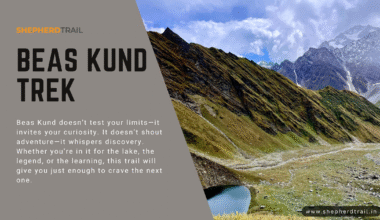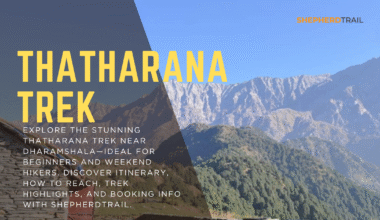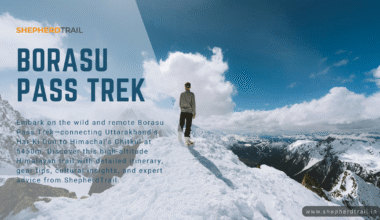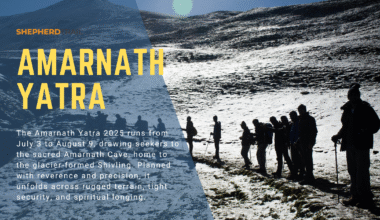Minkiani Pass Trek (Baleni Pass) – Where Peaks Remember Your Name
Where Every Trail Tells a Story – ShepherdTrail
Not all mountain passes are about the conquest. Some are about remembering — remembering how small you are, how vast the sky can feel, and how silence sometimes speaks louder than words.
The Minkiani Pass Trek, locally also known as Baleni Pass, is one such trail. Sitting high above the crystal-clear Kareri Lake, at the edge of Himachal’s Dhauladhar range, this route doesn’t just carry you across geography — it carries you into a different kind of presence. One where the elements dictate your pace and nature becomes both path and prayer.
The Forgotten Window Between Worlds
Often overshadowed by the more famous Indrahar Pass nearby, Minkiani (or Baleni) Pass remains one of the lesser-explored gems of Himachal Pradesh. It links the Kangra valley to the hidden folds of Chamba and sits at a dizzying height of around 4,000–4,250 meters.
The trek starts from Kareri village, winds its way past forests of pine and oak, skirts the sacred Kareri Lake, and pushes further into the granite corridors of the Dhauladhars. Unlike commercial trails, this one demands old-school trekking instincts — raw, remote, and rewarding.
Trek Snapshot
-
Region: Kangra & Chamba districts, Himachal Pradesh
-
Altitude: ~4,000–4,250 m (Minkiani/Baleni Pass)
-
Base Village: Kareri (near Dharamshala)
-
Duration: 5–6 days (ex-Dharamshala)
-
Trek Gradient: Moderate to Difficult
-
Season: June to October (avoid during heavy monsoon)
Minkiani Pass Trek Itinerary – The Trail, Day by Day
Let’s walk the trail — not just with boots, but with breath, intention, and respect.
Day 1: Dharamshala to Kareri Village (1,900 m)
Your journey begins with a drive through misty cedar forests and tea estates as you reach Kareri Village, a charming hamlet nestled about 27 km from Dharamshala. The villagers greet you with warm smiles and quieter eyes — they’ve seen many leave for the mountains, and they know not all come back the same.
Stay in a local guesthouse or pitch your tent by the river. Tonight, the sky will be your lampshade.
Day 2: Kareri Village to Kareri Lake (3,000 m | 10–12 km)
The trail starts gently, following the Nyund Nallah — a glacial stream that you’ll keep crossing via rustic wooden bridges. As you climb, the forest thins out and makes way for meadows and granite outcrops.
Then, like a secret finally shared, Kareri Lake appears.
Cradled beneath towering cliffs, Kareri Lake is not just a campsite — it’s a mirror to the heavens. The reflection of the moon in its still waters feels like a hymn. Locals believe the lake is sacred to Lord Shiva, and it’s easy to see why. The silence here is different — it hums in your bones.
Day 3: Kareri Lake to Minkiani Base Camp (3,600–3,800 m | 6–7 km)
From here, the trail turns steeper and wilder. You’re now in the alpine zone. Shrubs give way to boulders, and soon, even the boulders fade into snowfields and glacial debris.
The path to Minkiani Base Camp is raw — no railings, no signs, no tea stalls. Just you, the wind, and the sound of your heartbeat against the granite face of the Dhauladhar.
You’ll likely pitch tents on a flat patch above the treeline, hemmed in by peaks and echo. Nights here are cold, and stars seem close enough to reach.
Day 4: Base Camp to Minkiani Pass and back (4,200+ m | 8–10 km round trip)
Start early. The pass doesn’t forgive delays.
The final push to Minkiani (Baleni) Pass is a serious ascent — over scree, ice patches, and snow depending on the month. But once you reach the top, you’ll forget the strain. The pass opens up like a gate into myth.
To the north lies the Chamba valley, to the south, Kangra’s gentle plains. Around you, a kingdom of peaks — mute witnesses to your breathless awe.
You don’t summit Minkiani Pass — you are received by it.
Spend a brief, respectful moment here. Then descend back to base camp before weather turns.
Day 5: Return to Kareri Lake / Kareri Village
You can choose to descend directly to Kareri Village in a long push or camp again by Kareri Lake for a final night under the stars. Either way, your body is tired but your spirit is full.
Why This Trek Is Special
1. Sacred Geography
From Kareri Lake to the granite ridges of the Dhauladhar, every part of this trail is steeped in Himalayan spiritualism. Locals often say this region is guarded by deities, and trekkers are visitors, not conquerors.
2. Uncommercialized Wilderness
Unlike more tourist-trodden trails, this trek sees fewer crowds. It’s not for the checklist crowd — it’s for the seekers.
3. Natural Drama
The transition from subtropical pine forests to alpine lakes to icy high passes makes this a trek of contrast and crescendo. It starts quiet and ends sublime.
Comparisons and Reflections
If you’ve read our stories on Indrahar Pass, you’ll sense a similar mix of challenge and reward here, but with fewer footsteps around. Like Thatharna’s lonely ridgeline or Kareri Lake’s mirrored soul, the Minkiani Pass too asks for your solitude and offers revelations in return.
While Himani Chamunda introduces you to myths and thunders, this trail takes you deeper into silence, snow, and surrender.
Things to Keep in Mind
🏕️ Trek Difficulty
This is a moderate-to-difficult trek. While Kareri Lake is doable for fit beginners, the push to the pass requires stamina, weather-readiness, and gear awareness.
🎒 Gear Essentials
-
Good-quality trekking shoes (waterproof soles a must)
-
Layered clothing – thermal base, fleece mid-layer, waterproof outer
-
Gloves, wool cap, sunglasses, sunscreen
-
Trekking poles
-
Tent + sleeping bag (if self-supported)
-
Water purification tablets or filters
-
First aid kit and altitude sickness meds
-
Dry fruits, energy bars, and hydration salts
🕰️ Best Time to Trek
-
June to early July: Snow melt, clear trails
-
Mid-July to August: Monsoon bloom, but risky weather
-
September to October: Post-monsoon clarity, golden meadows
Avoid winter months — snow blocks the pass and increases avalanche risk.
Local Wisdom & Trail Ethics
-
Respect local customs – Kareri is not just a village, it’s a guardian.
-
Avoid littering – everything you carry in must come out.
-
Don’t pick flowers or stack stones — this land isn’t a backdrop, it’s a being.
-
Talk to shepherds — their stories carry maps no GPS can offer.
Final Words – The Pass That Whispers, Not Roars
The Minkiani Pass trek isn’t for everyone — and that’s the point.
It’s for those who don’t need applause at the end of a trail. For those who walk not to escape life, but to find it. For those who understand that sometimes, the highest places are the quietest.
Here, snow doesn’t dazzle — it listens. Rocks don’t block — they remember.
And if you leave a little lighter, a little more silent, a little more alive — the trail has done its job.
Trek With Us – Your Journey Awaits
At ShepherdTrail, we don’t just organize treks — we walk them with stories, soul, and safety. If you’re ready to step into the solitude and strength of the Minkiani Pass, we’ve got the logistics covered.
-
Small-group departures
-
Local guides with deep regional knowledge
-
All-inclusive trek packages
-
Optional add-ons: Kareri Lake camping, village stays, and spiritual detours
📞 To Book the Minkiani Pass Trek, call or WhatsApp us at 7340973455.
Let’s craft a journey where the trail remembers you.







